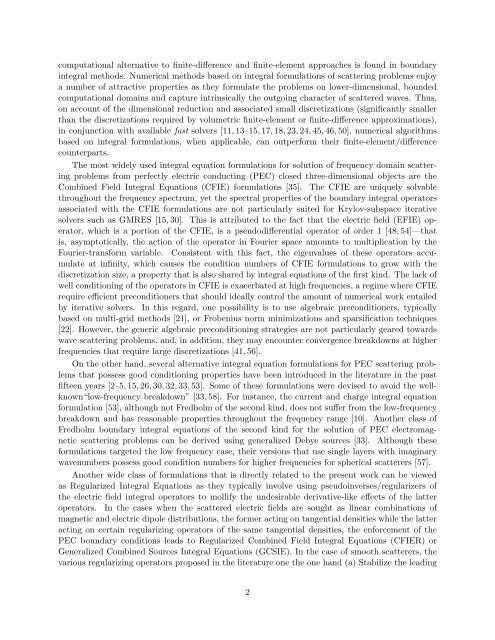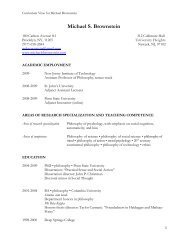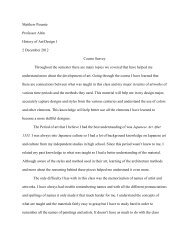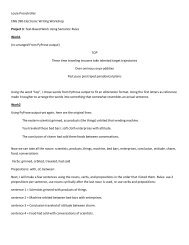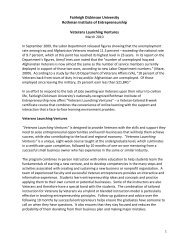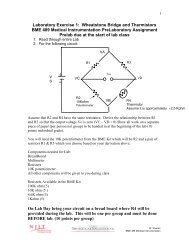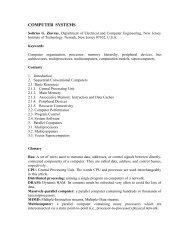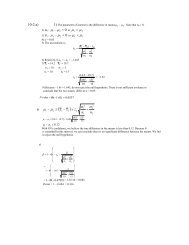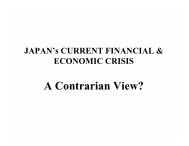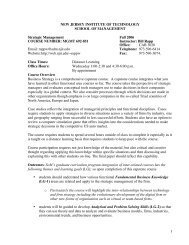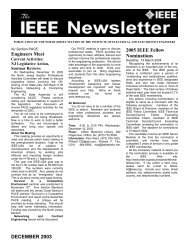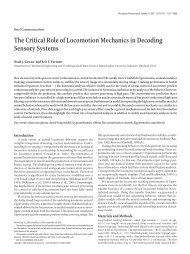Well-conditioned boundary integral formulations for the ... - Njit
Well-conditioned boundary integral formulations for the ... - Njit
Well-conditioned boundary integral formulations for the ... - Njit
You also want an ePaper? Increase the reach of your titles
YUMPU automatically turns print PDFs into web optimized ePapers that Google loves.
computational alternative to finite-difference and finite-element approaches is found in <strong>boundary</strong><br />
<strong>integral</strong> methods. Numerical methods based on <strong>integral</strong> <strong><strong>for</strong>mulations</strong> of scattering problems enjoy<br />
a number of attractive properties as <strong>the</strong>y <strong>for</strong>mulate <strong>the</strong> problems on lower-dimensional, bounded<br />
computational domains and capture intrinsically <strong>the</strong> outgoing character of scattered waves. Thus,<br />
on account of <strong>the</strong> dimensional reduction and associated small discretizations (significantly smaller<br />
than <strong>the</strong> discretizations required by volumetric finite-element or finite-difference approximations),<br />
in conjunction with available fast solvers [11, 13–15, 17, 18, 23, 24, 45, 46, 50], numerical algorithms<br />
based on <strong>integral</strong> <strong><strong>for</strong>mulations</strong>, when applicable, can outper<strong>for</strong>m <strong>the</strong>ir finite-element/difference<br />
counterparts.<br />
The most widely used <strong>integral</strong> equation <strong><strong>for</strong>mulations</strong> <strong>for</strong> solution of frequency domain scattering<br />
problems from perfectly electric conducting (PEC) closed three-dimensional objects are <strong>the</strong><br />
Combined Field Integral Equations (CFIE) <strong><strong>for</strong>mulations</strong> [35]. The CFIE are uniquely solvable<br />
throughout <strong>the</strong> frequency spectrum, yet <strong>the</strong> spectral properties of <strong>the</strong> <strong>boundary</strong> <strong>integral</strong> operators<br />
associated with <strong>the</strong> CFIE <strong><strong>for</strong>mulations</strong> are not particularly suited <strong>for</strong> Krylov-subspace iterative<br />
solvers such as GMRES [15, 30]. This is attributed to <strong>the</strong> fact that <strong>the</strong> electric field (EFIE) operator,<br />
which is a portion of <strong>the</strong> CFIE, is a pseudodifferential operator of order 1 [48, 54]—that<br />
is, asymptotically, <strong>the</strong> action of <strong>the</strong> operator in Fourier space amounts to multiplication by <strong>the</strong><br />
Fourier-trans<strong>for</strong>m variable. Consistent with this fact, <strong>the</strong> eigenvalues of <strong>the</strong>se operators accumulate<br />
at infinity, which causes <strong>the</strong> condition numbers of CFIE <strong><strong>for</strong>mulations</strong> to grow with <strong>the</strong><br />
discretization size, a property that is also shared by <strong>integral</strong> equations of <strong>the</strong> first kind. The lack of<br />
well conditioning of <strong>the</strong> operators in CFIE is exacerbated at high frequencies, a regime where CFIE<br />
require efficient preconditioners that should ideally control <strong>the</strong> amount of numerical work entailed<br />
by iterative solvers. In this regard, one possibility is to use algebraic preconditioners, typically<br />
based on multi-grid methods [21], or Frobenius norm minimizations and sparsification techniques<br />
[22]. However, <strong>the</strong> generic algebraic preconditioning strategies are not particularly geared towards<br />
wave scattering problems, and, in addition, <strong>the</strong>y may encounter convergence breakdowns at higher<br />
frequencies that require large discretizations [41, 56].<br />
On <strong>the</strong> o<strong>the</strong>r hand, several alternative <strong>integral</strong> equation <strong><strong>for</strong>mulations</strong> <strong>for</strong> PEC scattering problems<br />
that possess good conditioning properties have been introduced in <strong>the</strong> literature in <strong>the</strong> past<br />
fifteen years [2–5, 15, 26, 30, 32, 33, 53]. Some of <strong>the</strong>se <strong><strong>for</strong>mulations</strong> were devised to avoid <strong>the</strong> wellknown“low-frequency<br />
breakdown” [33, 58]. For instance, <strong>the</strong> current and charge <strong>integral</strong> equation<br />
<strong>for</strong>mulation [53], although not Fredholm of <strong>the</strong> second kind, does not suffer from <strong>the</strong> low-frequency<br />
breakdown and has reasonable properties throughout <strong>the</strong> frequency range [10]. Ano<strong>the</strong>r class of<br />
Fredholm <strong>boundary</strong> <strong>integral</strong> equations of <strong>the</strong> second kind <strong>for</strong> <strong>the</strong> solution of PEC electromagnetic<br />
scattering problems can be derived using generalized Debye sources [33]. Although <strong>the</strong>se<br />
<strong><strong>for</strong>mulations</strong> targeted <strong>the</strong> low frequency case, <strong>the</strong>ir versions that use single layers with imaginary<br />
wavenumbers possess good condition numbers <strong>for</strong> higher frequencies <strong>for</strong> spherical scatterers [57].<br />
Ano<strong>the</strong>r wide class of <strong><strong>for</strong>mulations</strong> that is directly related to <strong>the</strong> present work can be viewed<br />
as Regularized Integral Equations as <strong>the</strong>y typically involve using pseudoinverses/regularizers of<br />
<strong>the</strong> electric field <strong>integral</strong> operators to mollify <strong>the</strong> undesirable derivative-like effects of <strong>the</strong> latter<br />
operators. In <strong>the</strong> cases when <strong>the</strong> scattered electric fields are sought as linear combinations of<br />
magnetic and electric dipole distributions, <strong>the</strong> <strong>for</strong>mer acting on tangential densities while <strong>the</strong> latter<br />
acting on certain regularizing operators of <strong>the</strong> same tangential densities, <strong>the</strong> en<strong>for</strong>cement of <strong>the</strong><br />
PEC <strong>boundary</strong> conditions leads to Regularized Combined Field Integral Equations (CFIER) or<br />
Generalized Combined Sources Integral Equations (GCSIE). In <strong>the</strong> case of smooth scatterers, <strong>the</strong><br />
various regularizing operators proposed in <strong>the</strong> literature one <strong>the</strong> one hand (a) Stabilize <strong>the</strong> leading<br />
2


